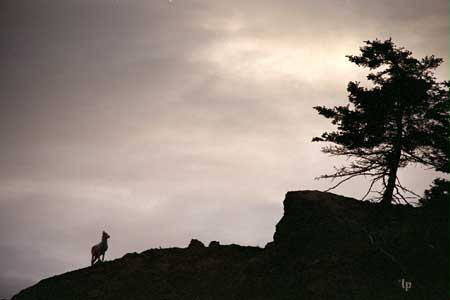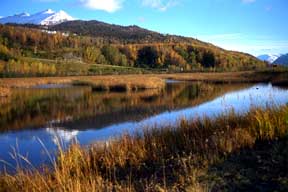|

The Drive Along Turnagain ArmThe 45-minute drive from Anchorage to Girdwood along the Turnagain Arm of Cook Inlet is one of the world's great drives, ranking right up there with Italy's Amalfi Drive and the highway along the Rhine south of Coblenz. The Seward Highway linking Anchorage and Seward is a National Forest Scenic Byway and one of 15 roads in the United States that has been designated as an "All-American Road." Because of this, the road is well-maintained so you won't need to trade in your car or check out auto refinance rates to finance a 4x4 or big SUV to navigate the route. From beginning to end there are dramatic views of mountain scenery and the inlet. There's a good chance of viewing dall sheep, such as the one in the photo above, and a somewhat lesser chance of seeing some of Cook Inlet's 350 beluga whales and an eagle or two. There's the possibility, too, of seeing the tide come in. Turnagain Arm's bore tide is the second highest in North America, second only to the tide in Canada's Bay of Fundy.
Visitors are most likely to observe dall sheep during the first part of their trip from Anchorage, as the road follows the base of rock outcroppings. Occasionally dall sheep come down to the highway but more often they're visible partway up a rocky mountain slope. Watch for cars that have pulled to the shoulder. That usually means someone has spotted some sheep. In the summer, rock climbers can be seen along this stretch of highway. In the winter, they give way to ice climbers.
Beluga Point, a few miles further along, offers dramatic views of the Inlet and owes its name to the beluga whales that can sometimes be sighted from there. The highway passes Indian Creek and Bird Creek where, if the season's right and the fish are running, fishermen can be seen lined up almost shoulder to shoulder along the shores. That's also a good time to look for belugas in the Inlet near the creek outlets -- they're there to catch some fish, too. A school of belugas can look a lot like white caps so binoculars are helpful in identifying them. There's a state recreation site, including a campground with 19 campsites, at Bird Creek. There are additional pullouts as the highway nears Girdwood, including a new one with a short trail from the parking lot along a headland. These last pullouts offer an opportunity to catch a first glimpse of Portage Glacier in the mountains at the far end of the Inlet. The best spots for eagle watching are near the creeks when the salmon are running and in the dead trees between the highway and the Inlet at the turnoff into Girdwood. The return trip to Anchorage late in the day offers an equally dramatic and very different drive. On a clear day, the distant Alaska Range may be visible in the fading daylight. On a misty day, the ranks of mountains surrounding the inlet may fade away into the distance.
|
|
|||||||||||||||||||||||||||||||||||||||||||||||||||||||||||||||||||||||||||||||||||||||||
Driving tipsThe highway between Anchorage and Girdwood is mostly two-lane with a new three-lane stretch near Girdwood. Traffic is usually heavy during the summer, and it can move slowly because of recreational vehicles and motorists pulling boats. Fishing activity around Bird and Indian creeks also can slow traffic. There are many curves but the road is fairly level, staying close to the Inlet for the entire distance. Other motorists may slow unexpectedly if they see whales or sheep. Don't play
|
 The
highway leaves Anchorage at Potter Marsh (shown in the fall in photo
at right), which attracts migrating birds and waterfowl in the spring,
summer and fall, and ice skaters in the winter. A long boardwalk
at the north end of the marsh allows birdwatchers to get closer
to birdwatchees.
The
highway leaves Anchorage at Potter Marsh (shown in the fall in photo
at right), which attracts migrating birds and waterfowl in the spring,
summer and fall, and ice skaters in the winter. A long boardwalk
at the north end of the marsh allows birdwatchers to get closer
to birdwatchees. Motorists
can pull off the highway to enjoy the view at several turnoffs along
the way. The first of these is at McHugh Creek, where there's a
waterfall (at right) within view of the highway. There's a picnic
area here too as well as a trail.
Motorists
can pull off the highway to enjoy the view at several turnoffs along
the way. The first of these is at McHugh Creek, where there's a
waterfall (at right) within view of the highway. There's a picnic
area here too as well as a trail. 
